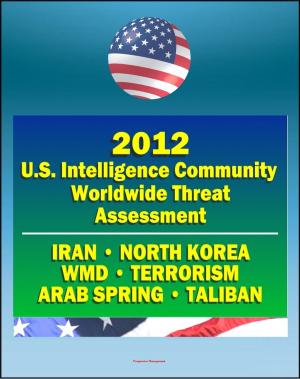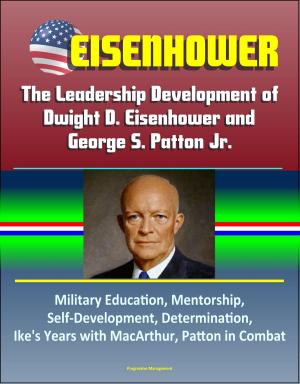The Effectiveness of Army Music in Accomplishing the Army Public Affairs Mission: Survey of Neuroscience Literature, Review of Audience Member Emotional Comments About Joy, Pride and Patriotism
Nonfiction, Entertainment, Music, Music Styles, Military & Marches, History, Military, United States| Author: | Progressive Management | ISBN: | 9780463075777 |
| Publisher: | Progressive Management | Publication: | May 6, 2018 |
| Imprint: | Smashwords Edition | Language: | English |
| Author: | Progressive Management |
| ISBN: | 9780463075777 |
| Publisher: | Progressive Management |
| Publication: | May 6, 2018 |
| Imprint: | Smashwords Edition |
| Language: | English |
This excellent report has been professionally converted for accurate flowing-text e-book format reproduction.
Army music units have historically conducted community engagement missions on behalf of Army Public Affairs to engender trust and confidence in the U.S. Army among U.S. citizens. Measuring the effectiveness of Army music in achieving that goal has, however, proven elusive. This study first shows through a survey of the existing neuroscientific literature dealing with the human brain's processing of music that music is the ideal medium for communicating these messages to the public. The study then offers a new model for a measure of effectiveness of Army music by examining a four-year collection of e-mail comments from audience members at The U.S. Army Field Band performances. Theses e-mails, of which 95 percent indicate positive or overwhelmingly positive reactions to the performances, demonstrate clear and powerful emotional reactions such as joy, pride, and patriotism. These emotional responses further show a link to the Army and to the Public Affairs mission of engendering trust and confidence in the U.S Army.
CHAPTER 1 INTRODUCTION * Army Bands * CHAPTER 2 LITERATURE REVIEW * Public Affairs * Emotions * Music as a Communications Medium * CHAPTER 3 METHODOLOGY * Limitations and Delimitations * CHAPTER 4 ANALYSIS * CHAPTER 5 CONCLUSIONS * Recommendations for Further Study * Recommendations for the Army Music Field * APPENDIX A SELECTED E-MAILS * BIBLIOGRAPHY
Recognizing the human element's effect on war, as posited by Clausewitz, in addition to realizing the impact of the ever-increasing flow of information brought about by rapid advancements in technology, the Army has placed growing emphasis on information operations (IO). The Army recognizes it must maintain a presence in the information domain to ensure that it has a voice in the broader public discourse throughout the range of military operations. An essential component of IO is public affairs (PA) activity, which fulfills the Army's obligation to "communicate with the American public." This communication requires honesty, forthrightness, and accuracy to ensure the continued trust of the American people. Field Manual (FM) 3-61, Public Affairs, includes community engagement activities within its definition of PA activities and acknowledges that they "help to establish conditions that lead to confidence in the Army and its readiness to conduct unified land operations." The Army requires the trust and confidence of the American people to remain relevant and effective; and while these things may begin as intellectual processes, they ultimately reside in the realm of emotions.
This excellent report has been professionally converted for accurate flowing-text e-book format reproduction.
Army music units have historically conducted community engagement missions on behalf of Army Public Affairs to engender trust and confidence in the U.S. Army among U.S. citizens. Measuring the effectiveness of Army music in achieving that goal has, however, proven elusive. This study first shows through a survey of the existing neuroscientific literature dealing with the human brain's processing of music that music is the ideal medium for communicating these messages to the public. The study then offers a new model for a measure of effectiveness of Army music by examining a four-year collection of e-mail comments from audience members at The U.S. Army Field Band performances. Theses e-mails, of which 95 percent indicate positive or overwhelmingly positive reactions to the performances, demonstrate clear and powerful emotional reactions such as joy, pride, and patriotism. These emotional responses further show a link to the Army and to the Public Affairs mission of engendering trust and confidence in the U.S Army.
CHAPTER 1 INTRODUCTION * Army Bands * CHAPTER 2 LITERATURE REVIEW * Public Affairs * Emotions * Music as a Communications Medium * CHAPTER 3 METHODOLOGY * Limitations and Delimitations * CHAPTER 4 ANALYSIS * CHAPTER 5 CONCLUSIONS * Recommendations for Further Study * Recommendations for the Army Music Field * APPENDIX A SELECTED E-MAILS * BIBLIOGRAPHY
Recognizing the human element's effect on war, as posited by Clausewitz, in addition to realizing the impact of the ever-increasing flow of information brought about by rapid advancements in technology, the Army has placed growing emphasis on information operations (IO). The Army recognizes it must maintain a presence in the information domain to ensure that it has a voice in the broader public discourse throughout the range of military operations. An essential component of IO is public affairs (PA) activity, which fulfills the Army's obligation to "communicate with the American public." This communication requires honesty, forthrightness, and accuracy to ensure the continued trust of the American people. Field Manual (FM) 3-61, Public Affairs, includes community engagement activities within its definition of PA activities and acknowledges that they "help to establish conditions that lead to confidence in the Army and its readiness to conduct unified land operations." The Army requires the trust and confidence of the American people to remain relevant and effective; and while these things may begin as intellectual processes, they ultimately reside in the realm of emotions.















